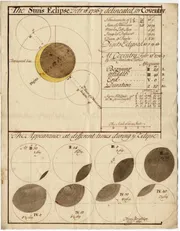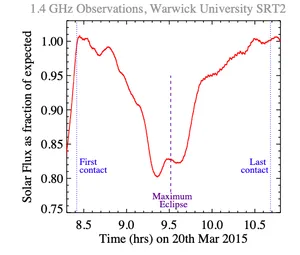Eclipses Seen from Coventry
Eclipses are one of the most striking of astronomical phenomena. While total solar eclipses (in which the Sun is entirely concealed behind the Moon) are rarely observed from any given location, partial or annular solar eclipses are more common. Lunar eclipses are still more so, but present the compelling "blood moon" phenomenon, when the Moon enters the Earth's shadow. Such events have been frequently reported in the local press, advising Coventrians on when and where to observe an eclipse, although it is less clear how much public response there was to such reports. However eclipse predictions were less readily available in the past. Research by the Director of the British Astronomical Association's Historical Section, and Rugby-resident, Mike Frost has investigated aspects of local astronomical history and has identified the existence in the Warwickshire County Archives of an eclipse chart made by Warwickshire astronomer and mathematician Henry Beighton for the total solar eclipse of 1736/7. This chart gives the eclipse extent and timings as seen from Coventry - presumably the nearest large town to both Beighton (who lived in rural Warwickshire) or his client (who lived near Nuneaton). The chart is both attractive and technically-complex, illustrating Beighton's knowledge and skill at making such detailed predictions.
Research by the Director of the British Astronomical Association's Historical Section, and Rugby-resident, Mike Frost has investigated aspects of local astronomical history and has identified the existence in the Warwickshire County Archives of an eclipse chart made by Warwickshire astronomer and mathematician Henry Beighton for the total solar eclipse of 1736/7. This chart gives the eclipse extent and timings as seen from Coventry - presumably the nearest large town to both Beighton (who lived in rural Warwickshire) or his client (who lived near Nuneaton). The chart is both attractive and technically-complex, illustrating Beighton's knowledge and skill at making such detailed predictions.
Local astronomy enthusiast William Andrews' diaries are held in Coventry Archives and report his attempts to view solar eclipses from Coventry in 1851 and 1858. The 1851 line of totality passed far to the north of the United Kingdom, and there was unlikely to be any visible evidence of the eclipse from the UK West Midlands. By contrast, the 1858 total solar eclipse passed through Northampton, albeit with a very brief period of totality, and would have been clearly visible as a high percentage partial eclipse from Coventry. Williams recorded that clouds gathered during the eclipse making it very difficult to observe, but that "it was about as dusky as at 6 o'clock in the evening". He also recorded observations of a partial eclipse of the Moon in 1860. Thereafter, Williams appears to have travelled overseas to view further eclipses, enquiring in the Astronomer's Register about the best location to view the eclipse of 1870, and recording journeys to see other events in the 1890s.
 Eclipse observing from Coventry is always likely to be limited, and subject to the vagaries of the English weather. However in 2015, the city experienced a morning solar eclipse in which 90 percent of the solar disk was obscured. At Warwick University, the Astronomy and Astrophysics group used this as an exercise in outreach, locating our telescopes and viewing equipment in the centre of campus, and inviting passers by to join us in observing the spectacle. We also made use of the 2.3m radio telescopes mounted on the roof of the Physics department to measure the dip in the solar flux at a frequency of 1.4 GHz, obtaining an interestingly W-shaped lightcurve.
Eclipse observing from Coventry is always likely to be limited, and subject to the vagaries of the English weather. However in 2015, the city experienced a morning solar eclipse in which 90 percent of the solar disk was obscured. At Warwick University, the Astronomy and Astrophysics group used this as an exercise in outreach, locating our telescopes and viewing equipment in the centre of campus, and inviting passers by to join us in observing the spectacle. We also made use of the 2.3m radio telescopes mounted on the roof of the Physics department to measure the dip in the solar flux at a frequency of 1.4 GHz, obtaining an interestingly W-shaped lightcurve.
(Image: Observed radio flux observed from the Sun during the Solar eclipse of March 2015, shown as a ratio to the expected flux. Observations were taken at 1.4 GHz, using the 2.3m diameter small radio telescope (SRT) on the roof of the Physics department at Warwick building. The Sun fortunately cleared buildings and other obstructions from the view of the telescope at about the same time as first contact. The double-dip lightcurve is consistent with obscuration of emission from the solar corona. Observers: Elizabeth Stanway & Hugh Osborn)
Sources:
"Henry Beighton and Astronomy in the Ladies' Diary", Mike Frost, J Br Astron Assoc, 124,131 (2014)
"Getting stated with the history of Astronomy", M Frost, J Br Astron Assoc, 123, 298 , (2013)
Diaries of William Andrews (2 volumes), Coventry Archives, PA119/1, PA119/2
